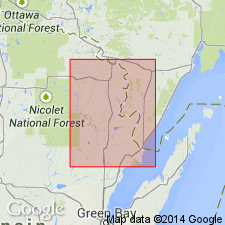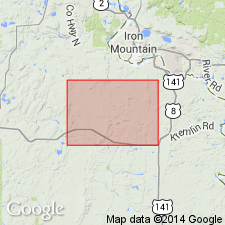
- Usage in publication:
-
- Newingham Granite
- Modifications:
-
- First used
- AAPG geologic province:
-
- Lake Superior region
Summary:
First used for rock unit mapped within Wisconsin Precambrian complex adjacent to town of Pembine, WI, and noted to be a 40 sq mi area, having intrusive contacts with greenstone, biotite gneiss, and hornblende gneiss.
Source: GNU records (USGS DDS-6; Reston GNULEX).

- Usage in publication:
-
- Newingham Granodiorite
- Modifications:
-
- Named
- Dominant lithology:
-
- Granodiorite
- AAPG geologic province:
-
- Lake Superior region
Summary:
Named as formation, presumably for exposures near the Newingham farm reportedly in northwestern part of the mass. Type section not designated. Geologic map (fig. 1) shows areal extent. Typically medium- to coarse-grained, leucocratic, gray granodiorite, with weak foliation exhibited by biotite. Xenoliths of Dunbar Gneiss and Quinnesec Formation common throughout. Characteristic minerals are feldspar, quartz, and biotite, together with hornblende, sphene, and epidote. Probably Middle Precambrian.
Source: GNU records (USGS DDS-6; Reston GNULEX).

- Usage in publication:
-
- Newingham Tonalite*
- Modifications:
-
- Redescribed
- Dominant lithology:
-
- Tonalite
- AAPG geologic province:
-
- Lake Superior region
Summary:
Formerly called Newingham Granodiorite (Cain, 1964). Redescribed on basis of more appropriate lithic designation. Named as one of three granitoid bodies which compose three respective lobes of Dunbar dome. Pembine lobe is composed of Newingham Tonalite. Dominantly light-gray, homogeneous, medium-grained, slightly porphyritic, foliated tonalite and granodiorite. Typically composed of 30 percent quartz, 55 percent zoned plagioclase, about 10 percent biotite, and sparse K-feldspar and hornblende. Northern part more heterogeneous and characterized by porphyroclasts of plagioclase as long as 3 cm and the presence of trace to as much as 35 percent K-feldspar in granodiorite phase. Foliation expressed by oriented crystals of biotite and hornblende and leaves of quartz; was produced by ductile cataclasis. Tonalite intrudes Dunbar Gneiss and Quinnesec Formation and contains numerous inclusions of each. Assigned to Early Proterozoic.
Source: GNU records (USGS DDS-6; Reston GNULEX).
For more information, please contact Nancy Stamm, Geologic Names Committee Secretary.
Asterisk (*) indicates published by U.S. Geological Survey authors.
"No current usage" (†) implies that a name has been abandoned or has fallen into disuse. Former usage and, if known, replacement name given in parentheses ( ).
Slash (/) indicates name conflicts with nomenclatural guidelines (CSN, 1933; ACSN, 1961, 1970; NACSN, 1983, 2005, 2021). May be explained within brackets ([ ]).

